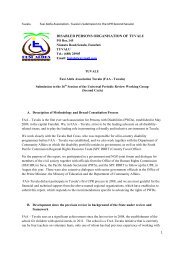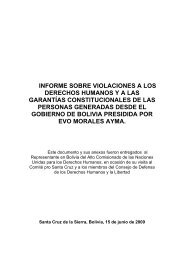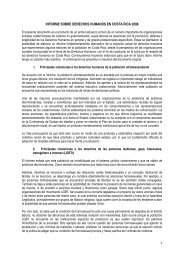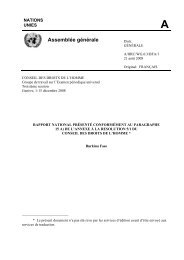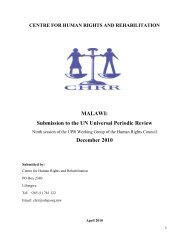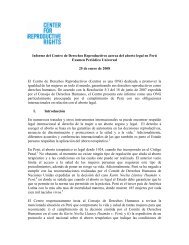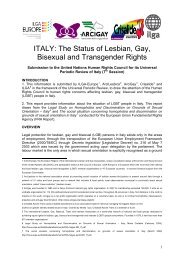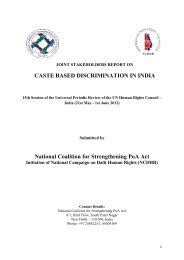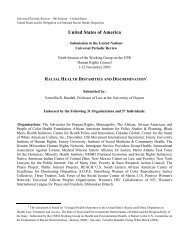Prison Needle Exchange: Lessons from a Comprehensive Review ...
Prison Needle Exchange: Lessons from a Comprehensive Review ...
Prison Needle Exchange: Lessons from a Comprehensive Review ...
Create successful ePaper yourself
Turn your PDF publications into a flip-book with our unique Google optimized e-Paper software.
keeping in mind that the primary objective of the program is to prevent shared use of<br />
syringes.” 188 The guidelines advise that “The number of kits to be supplied depends on the<br />
frequency of exchange and the user’s consumption habits: it should be sufficient to cover the<br />
inmate’s needs so that he does not have to reuse the syringe before the next day of<br />
exchange.” 189<br />
Second, prisoners participating in methadone maintenance are not disqualified <strong>from</strong><br />
accessing the needle exchange program. There are three reasons cited for this decision. The<br />
first is a recognition that some drug users on methadone will continue to inject either sporadically<br />
or habitually, and that this usually indicates that they are receiving an insufficient<br />
dose of methadone. The second is in recognition that people on methadone may still inject<br />
cocaine. The third is that methadone patients may act as “couriers,” obtaining sterile needles<br />
for other people who inject drugs who do not wish to identify themselves to the prison<br />
health unit. 190<br />
The guidelines also enable prisoners living in drug-free units or involved in abstinencebased<br />
programs to access sterile needles. It is recommended that requests for needles by<br />
these prisoners be “approached <strong>from</strong> a therapeutic point of view, and appropriate therapeutic<br />
measures taken to help him to overcome the relapse, but access<br />
to sterile injection material should never be denied.” 191<br />
The only instances in which participation in the needle exchange<br />
program is restricted are in the cases of persons with mental health<br />
issues who pose a danger or those classified as particularly violent.<br />
In each of these cases, the guidelines suggest that individuals be<br />
assessed on a case-by-case basis. For example, in the case of violent<br />
prisoners, prison officials are encouraged to “regulate the<br />
means of access by especially dangerous inmates, bearing in mind that it is always preferable<br />
to adopt special security rules with these inmates than to deny access to sterile<br />
syringes.” 192 Involvement in the program can also be denied if an individual uses a needle as<br />
a weapon, or continually violates program rules. 193<br />
Correctional officers<br />
reported very positive<br />
experiences with the needle<br />
exchange pilot project.<br />
Evaluation and lessons learned<br />
To evaluate the original Basauri pilot project, a monitoring committee was established to<br />
review and assess the program as it progressed. 194 Evaluations that involved consulting prisoners<br />
and staff were conducted at zero, three, and six months. A 12-month evaluation was<br />
deemed impossible, as the prison’s high turnover rate meant that<br />
few prisoners remained in the institution <strong>from</strong> the start of the pilot<br />
until the 12-month point. However, an evaluation with prison and<br />
non-governmental organization staff was done after 22 months.<br />
The prisoners accessing the program experienced no obstruction<br />
<strong>from</strong> correctional officers, and supported the fact that the program<br />
was run by the external non-governmental organization. It was noted<br />
that this personalized aspect of the program was preferable to an<br />
anonymous dispensing machine. Furthermore, the evaluation found that drug consumption<br />
among the prisoners had not increased and that there was a reduction in high-risk behaviours.<br />
Correctional officers also reported very positive experiences with the pilot. They reported<br />
no problems or conflicts with prisoners as a result of the program, and there were no instances<br />
of syringes being used as weapons. While they considered the program to be positive, they<br />
expressed a preference that it be run by prison staff rather than by an external organization.<br />
The staff of the non-governmental organization reported no instances of prisoners being<br />
<strong>Prison</strong> needle exchange<br />
programs facilitate referral<br />
of users to drug addiction<br />
treatment programs.<br />
34 <strong>Prison</strong> <strong>Needle</strong> <strong>Exchange</strong>: <strong>Lessons</strong> <strong>from</strong> a <strong>Comprehensive</strong> <strong>Review</strong> of International Evidence and Experience



